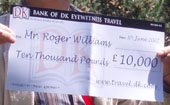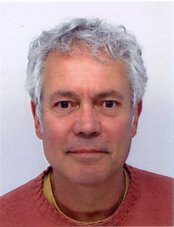_
PICTURE THIS...
The first and only time I was ever given a bonus at work, I went straight out to Museum Street opposite the British Museum and bought two lithographs by David Roberts:
A Coffee Shop in Cairo (right) and
Feluccas on the Nile. They seemed to me then – and still seem to me today, after I have finally made the journey – the ideal of romance. Of course by now I also wanted to find out what had happened to the old
Hotel Bristol in Cairo ("
children and servants half price, evening dress optional," says an old Baedeker). But lack of time combined with ferocious traffic (in a city of 20 million, there is not a traffic light in sight) kept me from the site where it once stood. I suspect it went up in smoke like it's more famous neighbour, Sheppards' Hotel, and other British outposts, on one particular incendiary nationalistic night, Saturday January 26, 1952.
THE ITINERARYMoney being no object, we went for a tailor-made tour from
Bales, booked through North South Travel: three nights in Cairo, then fly to Luxor for four nights on a cruise boat that would take us up to Aswan, where we would have three nights in a hotel. We had guides when we wanted them – to show us around the main sights – and free time to mooch in the soukhs, walk the promenades, and get into trouble. We took mosquito repellent and probiotics to prevent stomach upsets.
THE SIGHTS

In Cairo we visited the Pyramids at Giza and the E
gyptian Museum; left to our own devices we headed for the Coptic quarter and the Khan al-Khalili soukh, a fantastic warren that is perhaps bigger than the Grand Bazaar in Istanbul. At the start of the cruise there were the temples of Luxor and Karnak, and the tombs and temples of the Valley of the Kings and Valley of the Queens to tackle. And the Luxor soukh. Heading upriver we stopped at the temples of Edfu and Kom Ombo, and Aswan, the last stop, revealed the Philae Temple, beautifully re-established on its own island, with an instructive sound and light show – to be on the water in the dark is magic. We learnt a lot from Sally in Cairo and Mona on excursions from the boat, both steeped in knowledge of ancient gods and pharaohs. Other side trips were on offer (Saqqara, Memphis, Abu Simbel) but this seemed quite enough.
 THE RIVER
THE RIVERA disappointment was that although we had four night on the boat, only one day was spent actually underway, and it was just the best bit, watching the bankside life, the biblical scenes of small villages, donkeys, sugar cane cutters and spear fishermen. There were many black-and-white kingfishers, egrets, squacco and night heron. The world's longest river is a majestic waterway and, particularly when seen from the air (on the hour-long flight from Cairo to Luxor, where we picked up the boat), it is strange to see that this is just about all there is to Egypt - the cultivated strip along its banks. Everything else, 96 percent, is desert.
 ACCOMMODATION
ACCOMMODATIONWe paid extra for our room at
Le Méridien Pyramids in Giza to have a Pyramid view. You could even see them from the pool. From here it was a lively 30-minute drive to the centre of the city. At Luxor we stayed a night in the riverfront
Sonesta St George, with a balcony overlooking the Nile. Our boat, the
Nile Beauty (above) was comfortable, spacious and a decade or two old. When moored, we often had to walk through other boats to reach ours, some as bling as tarts' boudoirs. Our cabin was on the lower deck and had a window at water level that blacked out when another boat was moored up against us. The
Pyramisa Isis Island in Aswan was our final destination, a large, impersonal modern 'resort' hotel that could not be better sited, on its own island, a backwater of peace, with pools and restaurants and not many people. A boat plied endlessly back and forth to the 'cityside'.
FOODBrilliant and generous, both on the boat and in the hotels. This is not a great meat-eating country, but the vegetables are healthy and hearty, innovatively prepared, with echoes of Turkish food, lighty spiced and full of flavour. Tasty breads, pastries and yoghut dishes, too.
 BAZAARS AND BACKSHEESH
BAZAARS AND BACKSHEESHEverywhere, people touted for business and asked for
backsheesh - tourist police, taxi drivers, caleche coachmen, bazaar traders. Pleas included...
"No hassle, no bloody hassle."
"Everything free today."
"Come and look inside, nice shirt, scarfs, bags, gelebayas, rubbish..."
• All photography inside the tombs is forbidden, and cameras must be handed in at the entrance to each tomb. At the tomb of Tutankhamun, the guard who took my camera looked furtively around. Few people were about. "Picture?" he said, turning the camera on me. So a few piastres bought me an illicit photograph of myself at the entrance to the tomb.
• Early one morning a fisherman was rowing by some 20 metres from the shore. I waved and he waved back, calling out "
backsheesh,
backsheesh!" like a gull's weary cry.
• About to enter a cafe on the Luxor promenade, I was stopped by an elderly
fellah, who wanted to know what I was going to drink. The cafe charged too much for beer, he said. If I gave him the money he would go and buy some cans from a local shop at a fraction of the price and I could sit with him and his friends and enjoy many drinks. It was an irresistible offer, and I imagined myself back home accosting a visiting businessman on his way to the Hilton's Zeta bar with a similar proposition: "
Why, for the price of your cocktail, my good sir, we could take a couple of bottles of the finest Bulgarian red into Hyde Park and put the world to rights."
 BEST BITS
BEST BITS
Felucca trips A cataract is an agglomeration of rocks and islands that, before the Aswan Dam was built, made the river hard to navigate: the first cataract on the Nile is at Aswan just below the dam, a pleasant area to sail around. This picture of a felucca was taken from Isis island where our hotel was.
 Ancient Egypt
Ancient Egypt None of the sights were a disappointment. On the contrary, they were magnificent, and still pretty much as David Roberts drew them; he was not exaggerating. From the haunting, medieval back streets of Cairo to the towering forest of the hypostyles, from the beautiful paintings and reliefs (and the delightful stick figures in the tomb of Thutmosis III in the Valley of the Kings) to the inventive hieroglyphics, we 'enjoyed our eyes' as the Egyptians say. The journey put history into perspective, working down through the centuries as we went up the Nile from the Old Kingdom Pyramids towards the Greek and Roman temples.
 An impression
An impression A surprise was to see the violence that had been inflicted by the early Christians on the beautiful relief figures on temples in the Upper Nile (as at Philae, right). It was similar to the gouging out of saints' eyes by Muslims in Byzantine churches, or the decapitation of saints on the facade of Ely Cathedral by Protestants, and of course reminiscent of the destruction of the Bamyan Buddha in Afghanistan. There is no religion without fanaticism.
Souvenirs Silver jewellery, essence of Lotus (as worn by Tutenkhamun). The soukhs were extraordinary, the spice stalls in Aswan unsurpassed – we bought cumin, dried lotus flowers, hibiscus and tamarind tea, and powdered indigo – to add a dash to our washing and make it whiter than white, as Egyptians told us their mothers used to do.
Festive moments Wedding receptions in the hotels were always a highlight: pipes, trumpets, drums, ululating, dancing hobby horses – exuberance without alcohol.
But of course the river was the star...




























